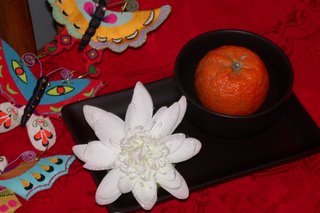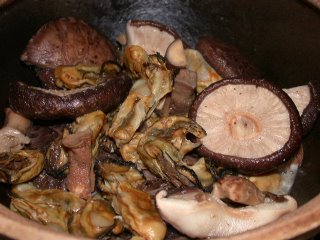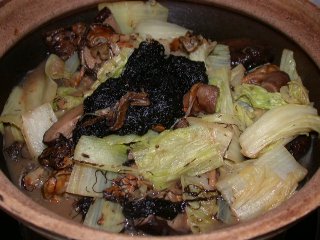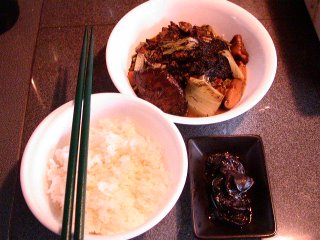Happy Chinese New Year - Hou Xi Fatt Choy! (WHB #17)
 It’s the 1st day of the Chinese New Year! How do I know this? Because the lion dancers started playing at 9am in the morning, that’s how!
It’s the 1st day of the Chinese New Year! How do I know this? Because the lion dancers started playing at 9am in the morning, that’s how!I was having a fantastic dream involving Hugh Jackman, a jar of butterscotch and a bowl of melted chocolate when a large bolt of lightning streaked through the sky and struck the poor man right on the noggins!
The thunderous drums accompanying the lion dancers had woken me up. Fortunately I had consumed enough dream chocolate covered strawberries, fed to me by my love slave Hugh Jackman, not to be truly pissed off.
Peering out my window I could see people walking around purposefully as they traveled to family and friend’s abodes for their Chinese New Year visits. I stretched indolently knowing that I had a leisurely afternoon planned. I planned to have a quiet day in and would cook only one dish today in honour of the special occasion – Hou Xi Fatt Choy.
Now Hou Xi Fatt Choy is no ordinary dish. The name itself evokes all the well wishes, good intentions and wistful hope for the future that this season brings. Metaphorically it means To Wish That Everything Will Prosper. A pretty fabulous wish, isn’t it? I rather like it.
Literally, it means dried oyster (hou xi) and black sea moss (fatt choy). Which is what the dish is made of. Hou xi sounds a little like “all things” and fatt choy sounds exactly like “to strike it rich” in Cantonese. With such auspicious names, no wonder the Chinese serve this dish during the 15 days of the Chinese New Year celebrations.
Made of dried oysters, black sea moss, dried shiitake mushrooms and Tientsin cabbage in a thick broth of oyster sauce, Hou Xi Fatt Choy truly carries with it all the rich history and lush aspirations of the Chinese.
My first encounter with this delectable offering from the sea was when my grandmother served it one Chinese New Year. We had some guests visiting us from Hong Kong and in honour of these guests, she decided to make a typically Cantonese dish. I’d never had it before and at my first gander of it, I was rather dubious of the mysterious, dark colour and the pungent, musky odour emanating from the large claypot.
I changed my mind when I took my first bite of a plump mushroom literally dripping a sinuous trail of brown nectar onto my rice. What was this flavour? It tastes of everything you could ever imagine from the sea. I was completely won over and basically finished the entire claypot of Hou Xi Fatt Choy that night!
My indulgent grandmother knowing that this was my favourite Chinese New Year dish, made it a point to cook Hou Xi Fatt Choy every year that I was visiting – much to my aunts’ and cousins’ jealousy. For some reason I never learnt how to make it from her. It was probably because it was such a seasonal dish and I was not always home during the Chinese New Year.
Finally, in my mid-twenties, I decided to try to recreate the dish myself. Happily, I was successful at the first try and I have been making it almost every Chinese New Year since. It is my little superstition to eat this dish on the first day of Chinese New Year just in case it does bring superb fortune and prosperity. So far, I am still waiting …
Fatt Choy aka Black Sea Moss
 No, this is not Kate Moss in her current state. One of the most unusual ingredients in Hou Xi Fatt Choy is the fatt choy bit, otherwise known as black sea moss. It is the most unprepossessing ingredient. Frankly, it looks like a gag gift from Halloween.
No, this is not Kate Moss in her current state. One of the most unusual ingredients in Hou Xi Fatt Choy is the fatt choy bit, otherwise known as black sea moss. It is the most unprepossessing ingredient. Frankly, it looks like a gag gift from Halloween.A tangle of black strands that looks like the toupee my Science teacher sported in college, fatt choy looked incredibly unappetising. I truly wonder at the first Chinese talking a walk along the beach who decided, “Hey, what’s this? Looks like someone lost their toupee. Oh yums, let’s eat it.” Was the man smoking his mushrooms instead of cooking it? Did the ancient Chinese actually go around sinking their teeth into unsuspecting wig wearers? The mind boggles.
The scientific name for fatt choy is a real mouthful, as they all are - Nostoc flagelliforme. I think it sounds like some fortune telling dominatrix myself and will refer to it as the more romantic sounding fatt choy, if you don’t mind. Despite its name of black sea moss, fatt choy actually does not come from the sea. Instead, it is found in the northwest desert steppes of China and Mongolia, between the rocks in streams or rivers flowing down from the mountains.
Harvesting fatt choy is a tricky business since they grow so high up, and only in autumn. The Chinese prove that they are pretty tricky themselves by using monkeys to reach the coveted fatt choy. Gives new meaning to pay peanuts, get monkeys … get prosperous!
However, fatt choy is not just a wishful hope for fortune. Eating fatt choy during Chinese New Year makes a lot of sense too. With the feasting and consumption of rich foods during this period, fatt choy’s ability to counteract this makes it not only auspicious but necessary. Fatt choy can apparently cleanse the stomach and intestines as it is a gentle fibre, thus aiding digestion. It also helps lower blood pressure.
Fatt choy is rich in calcium, iron and phosphorus. As with most seafood (well, sort of), it is a rich source of proteins and in fact, has a higher protein content than even eggs.
 In its dry form, fatt choy looks even worse than when cooked. Matted and crunched up with a rustling, coarse texture that is a complete ringer for some hobo’s hair (not that I go around caressing hobos’ hair), fatt choy typically comes packaged in a clump. You either tear it up or use the whole lot as it melts into a soft, fine … well, clump. But fear not, it breaks up into little fine strands as you cook so it really will not be like eating freshly washed hair.
In its dry form, fatt choy looks even worse than when cooked. Matted and crunched up with a rustling, coarse texture that is a complete ringer for some hobo’s hair (not that I go around caressing hobos’ hair), fatt choy typically comes packaged in a clump. You either tear it up or use the whole lot as it melts into a soft, fine … well, clump. But fear not, it breaks up into little fine strands as you cook so it really will not be like eating freshly washed hair.The Chinese government apparently banned the harvest of fatt choy in 2000 as it was eroding the grassland but it is still widely available in Asia. So I am not too sure if that ban is still in place or other sources of fatt choy have been discovered. Of course there are fake fatt choy. All Chinese delicacies have fakes! To spot a fake, you have to buy it first. Because the only way to tell is if the water in which the fatt choy is soaked turns black. Real fatt choy will not discolour the water. So I guess it is a case of the chicken or the egg here.
Hou Xi Fatt Choy
 8 big, fat dried shiitake mushrooms, soaked in water till soft
8 big, fat dried shiitake mushrooms, soaked in water till soft
– reserve the water
20 dried oysters, soaked in water till soft
- reserve the water
6 conpoy (dried scallops), soaked in water till soft
- reserve the water
1 clump of fatt choy or black sea moss the size of your hand
1 Tientsin cabbage
2 cloves garlic, crushed
3-4 tbsp oyster sauce
¼ cup of clam juice
1/3 cube of chicken stock
½ tsp of sugar
1 tbsp peanut oil 1. Wash your cabbage and slice them in half lengthwise and chop into 1 inch strips crosswise
1. Wash your cabbage and slice them in half lengthwise and chop into 1 inch strips crosswise
2. Slice the stalks off the mushrooms and discard the hard and coarse ends, reserving the more tender portions of the stalks. Cut the mushrooms in half if they are too big, otherwise leave them whole
3. Strain the reserved water from the oysters, mushrooms and conpoy through a muslin to remove the grit and dirt and combine all in a bowl
4. Heat the oil in the claypot on medium heat and sauté the garlic cloves till they are slightly blistered and golden
5. Add the oysters and quickly stir fry for about 30 seconds before adding the mushrooms, stir frying quickly till fragrant
6. Add the clam juice and continue stir frying as you add enough oysters/mushroom/conpoy water to almost cover the oysters and mushrooms
 7. Add the conpoy, oyster sauce, chicken stock cube and sugar and braise the lot. Taste to see if you need to add additional oyster sauce if it needs salt or sugar or the water if it is too salty
7. Add the conpoy, oyster sauce, chicken stock cube and sugar and braise the lot. Taste to see if you need to add additional oyster sauce if it needs salt or sugar or the water if it is too salty
8. After about 20-25 minutes, add the Tientsin cabbage and braise on low till the vegetables are just tender. Adjust the seasoning if required and stir occasionally to ensure even cooking 9. Soak the fatt choy in some warm water and then gently remove it from the water and add to the claypot
9. Soak the fatt choy in some warm water and then gently remove it from the water and add to the claypot
10. Stir to mix the ingredients and leave to braise for another 10 minutes
11. Serve hot with rice
 Hou Xi Fatt Choy tastes even better the next day. Just add a little more water and heat it up and it’s even more delicious than before. I had my Hou Xi Fatt Choy with some steamed Chinese liver sausages and hot, steamed rice. For once I can’t wait to have the leftovers!
Hou Xi Fatt Choy tastes even better the next day. Just add a little more water and heat it up and it’s even more delicious than before. I had my Hou Xi Fatt Choy with some steamed Chinese liver sausages and hot, steamed rice. For once I can’t wait to have the leftovers!  I am also posting this for Kalyn's Kitchen Weekend Herb Blogging #17 since I think a lot of people would find fatt choy both interesting and scary. Maybe they will feature it on Fear Factor! LOL.
I am also posting this for Kalyn's Kitchen Weekend Herb Blogging #17 since I think a lot of people would find fatt choy both interesting and scary. Maybe they will feature it on Fear Factor! LOL.
So to all and sundry, Gong Xi Fa Cai and Hou Xi Fatt Choy!
Categories - Call Me Others, VeggieMight, Chinese Herbs

8 Comments:
This is so wonderful. Your writing and your photos are just top notch. I hope that everything will prosper for you. I have a feeling that it will.
Gong Xi Fa Cai!
I really love Hou Xi Fatt Choy - I last had it at CNY a couple of years ago in Penang at a meal whose details I only remember rather vaguely - there was an enormous dish of Yee Sang in there somewhere and some Hasma in my pudding. Wishing you a happy and prosperous year!
Awww, thanks girls! Kalyn, you are too kind. I still have a ways to go with my writing and photos. I still have not figured out how to use my crappy camera for one! And I hope we both prosper in 2006! And maybe take a foodie vacation to Thailand and India together! Woo hoo!
Squeezie, Xing Nian Kuai Le! You know I never quite figured out what hasima is. I am not sure I like it too!
Lisa - yeah, it was a gooood dream. Damn those lion dancers!
This comment has been removed by a blog administrator.
wow~ what an interesting dish!
I'm not sure if my grandma has ever cooked this one =p
And yes, you are right, the thought of eating it kinda scares me now. But I think it's the same case as when I was hesitant to eat black chicken medicated soup but ended up loving it.
Gong Xi Fat Chai to you!!
Happy New Year to you...
I like the sound and look of this dish. I'll pass it on to my friend - she will surely love this and love you!
Uhm, Hugh Jackman, ey?
Hey, Strawberry, Gong Xi Fa Cai! I think your grandmother might have cooked this if she is Cantonese. I'm not sure if the other dialects groups cook this. And I love black herbal chicken soup although I remember asking if chicken had negro and white blood lines too.
Mae, Happy Chinese New Year! Well, that's good .. at least someone will love me then! And yes, Hugh Jackman. Not that I am into overly hirsute man a la Wolvie although he was one of my fave comic characters ... but definitely Hugh Jackman. Droool.
Oh,wow, that's fascinating. Thanks for sharing the details about that dish. I'm very intrigued and actually considering making it. Happy New Year!
Post a Comment
<< Home